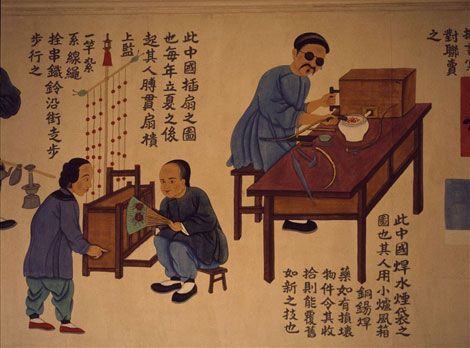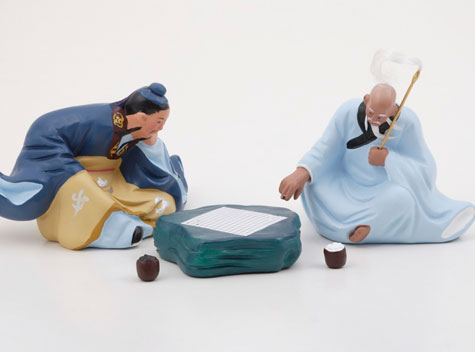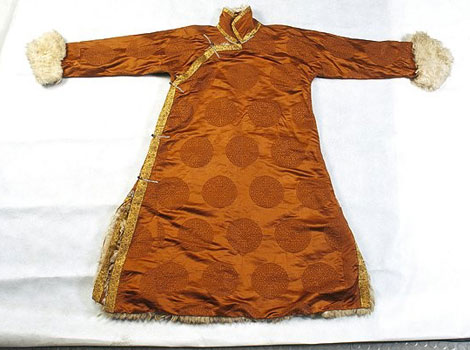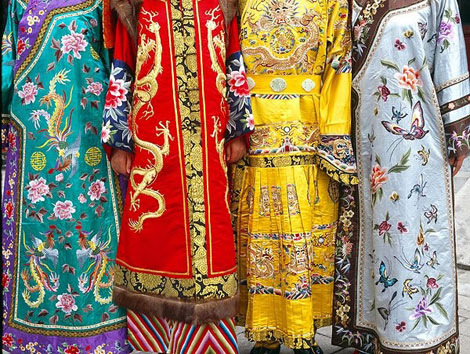 The ancient Chinese clothing consisted mostly of robes. While the women wore lengthy tunics that reached the ground, the men wore tunics that reached their knees. The sleeves of the garments were wide, and loose fitting, with sashes being added as ornamentation. Darker shades were preferred over light ones. Lighter coloured clothing was worn more commonly by the common people. The original ancient Chinese clothing was referred to as the Han Chinese clothing. The outfit was called the Hanfu. With the coming of various dynasties, the hanfu underwent a lot of modifications.
The ancient Chinese clothing consisted mostly of robes. While the women wore lengthy tunics that reached the ground, the men wore tunics that reached their knees. The sleeves of the garments were wide, and loose fitting, with sashes being added as ornamentation. Darker shades were preferred over light ones. Lighter coloured clothing was worn more commonly by the common people. The original ancient Chinese clothing was referred to as the Han Chinese clothing. The outfit was called the Hanfu. With the coming of various dynasties, the hanfu underwent a lot of modifications.
 Primarily, there were three variations of ancient Chinese garments
Primarily, there were three variations of ancient Chinese garments
 PIEN-FU: A 2 piece ceremonial costume, consisting of a tunic top extending to the knees, and worn with ankle length skirt or trousers.
PIEN-FU: A 2 piece ceremonial costume, consisting of a tunic top extending to the knees, and worn with ankle length skirt or trousers.
 CH'ANG P'AO: This is a one-piece ankle length tunic dress.
CH'ANG P'AO: This is a one-piece ankle length tunic dress.
SHENYI: A combination of the first two, a shenyi is a 2 piece top and trouser/skirt outfit that has been sewn together to make a one-piece garment.
The earliest dynasty recorded, the Shang Dynasty (c.1600 BC-1000 BC), developed the fundamentals of the Hanfu; it was made up of a knee-length tunic tied with a sash, with narrow cuffs called yi, a narrow, ankle-length skirt, called shang. This was accompanied by a bixi, which was a length of fabric that reached the knees. Since technology was limited, the only colours that could be used were primary colors- red, blue , yellow and green. It was a unisex outfit worn by men and women alike. The higher strata of society of course had more elaborate work and motifs on it in spite of the limited colors available.
The following dynasty, the Western Zhou Dynasty managed to enforce a social system in the ancient Chinese clothing. This was displayed by the complexity in their outfits. The higher the rank, more flamboyant and ornate their attire. This included the length of a skirt, the wideness of a sleeve and the degree of ornamentation. Further, the Hanfu became looser. The sleeves were wider and the yi was fastened with a sash which was adorned with jade ornaments. Since left-handedness was looked down upon, the yi was essentially draped in a style known as jiaoling youren, or wrapping the right side over before the left. The shenyi came into force under the Eastern Zhou Dynasty. It is a kind of a combination of a tunic and skirt where the upper and lower halves were cut separately but sewn into one piece. Another additional modification was that left end of the dress was reshaped into a kind of border which could be fastened in front on the chest. This modified dress was quickly adapted.
In the ancient Chinese Clothing most of the traditional designs were unisex uncomplicatedly cut. However, as the dynasties changed, gender specificity came into the shenyi. The men typically wore pants and women, skirts. Each dynasty had their own styles of Hanfu as they evolved.
During the winter months in the ancient China, to keep them warm, people wore padded jackets over the tunics. Though it is considered very common in China, yet silk, as a fabric was restricted to the rich. The poor wore hemp or ramie.





